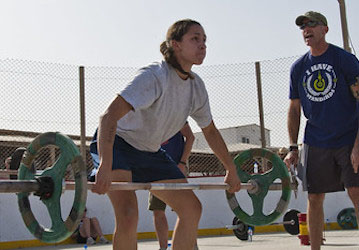The Air Force standard Physical Fitness Assessment (PFA), also known as the Tier 1 PFA, tests muscular endurance and cardiorespiratory endurance. The PFA consists of 3 events: a test of cardiorespiratory endurance with either a 1.5-mile run or 20-meter shuttle run, a push-up assessment doing either 1 minute of standard push-ups or 2 minutes of hand-release push-ups, and a core-muscle endurance test doing either 1 minute of traditional sit-ups, 2 minutes of cross-leg reverse crunches, or a plank exercise for maximum time. Learn more about the training principles that will help you get ready for the Tier 1 PFA.
Muscular endurance
Muscular endurance is the ability of your muscles to move or contract for long periods of time—or to contract as many times as possible in a set period of time. Examples include holding a plank or doing as many push-ups as you can in 1 minute. The PFA’s push-up test and sit-up components measure muscular endurance and core stability because they require you to do a maximum number of repetitions in a set period of time.
Muscular endurance is often used as the base component of muscular fitness. The lighter weights used make it easier to learn the proper form before you move to heavier weights and train to improve muscular strength and power. To improve muscular endurance, the National Strength and Conditioning Association recommends you lift 67% or less of your one-rep max for at least 12 reps per set, with less than 30 seconds of rest between sets. Training muscular endurance is one of the few times when limiting rest is helpful because it stresses your muscles’ energy systems by limiting the time for your muscles’ energy stores to replenish, forcing them to adapt to that stress.
For the push-up and sit-up events, basic core stability will be half the battle. For both exercises, start with a base core-strengthening program. Then work on chest and arm muscle endurance to do push-ups.
For the sit-ups, crunches, or plank, general core-strengthening programs are just as effective at improving sit-up performance in a PFA as training by doing sit-ups in every workout. The benefit comes from the reduced strain on your back and hip flexor muscles that can possibly lead to pain or injury.
When training to improve your muscular endurance, it might help to focus on one muscle group at a time, rather than doing supersets (a group of exercises one right after the other) of muscle groups. Supersets, while efficient time-wise, build in too much rest for each specific muscle group to fully train for muscular endurance.
Cardiorespiratory endurance
Cardiorespiratory endurance (CRE) is the key area of fitness measured in the 1.5-mile run and 20-meter shuttle. Although you’ll be tested on your ability to run fast enough to meet the standard, activities like tennis, hiking, swimming, and biking can help improve your CRE. (In addition, they can make training more fun if you don’t like to run.) Adding variety can also make it easier to train if you have bad hips, knees, or ankles because it reduces the forces on those joints. If you have nagging pain or injuries but don’t have a profile exempting you from the two running events, swimming, biking, and rowing are great ways to keep up your CRE. You should still run a couple times every 2 weeks, but it doesn’t necessarily need to be the focus of your training.
Run training to improve speed is also good for improving your CRE. When designing your training program, try not to get tunnel vision and think speed workouts are only for speed. Remember to track your total mileage during a speed workout, and avoid adding another 2–3 mile run to the end of it so you don’t overtrain and increase your risk of injury.
To see improvements in CRE, you’ll want to train at least twice a week, and work out at 60–80% of your maximum heart rate (max heart rate = 220 – your age). Keep in mind that if you’re doing speed workouts in your 2–3 CRE training sessions per week, your heart rate will likely go above 80%, and that’s okay.
Muscular strength
Muscular strength is the ability of a muscle to exert a maximal or near maximal force—or how much weight you can push, pull, or lift. Even though the PFA isn’t a true test of muscular strength, incorporating strength-building goals and workouts can help improve your performance during muscular endurance tests.
Those who don’t regularly weight train can expect to see strength gains with focused training in as little as 2 weeks as muscle activation—your body’s ability to fire more of the muscle fibers that make up a muscle—improves. As you continue working out, after about 4–6 weeks, you should start to see muscle mass gains.
Fueling for the PFA
As always, make sure you’re well hydrated in the days leading up to the test. Don’t wait until the day of the event to drink up. Since the whole test should take less than an hour of total activity, you should be fine with water, rather than a sports drink.
Plan to have a light, 200–300 calorie, high-carb snack like a bagel and some fruit 1–2 hours before the start of the test so you stay energized through every event. Since the test should be less than an hour of activity, you probably won’t need much between events. But if you feel yourself starting to crash, small snacks or sports drinks with small to moderate amounts of carbs might help improve your endurance. For more information on nutrient timing, see Chapter 9 of the Warfighter Nutrition Guide.
Bottom line
Preparing for the PFA should be a months-long training progression. To get the most out of your physical training, make sure to get help from a Physical Training Leader (PTL) or other fitness professional.
